Effective Communication Strategies for Success
VerifiedAdded on 2020/06/04
|11
|3328
|286
AI Summary
This assignment delves into the importance of effective communication in business contexts. It emphasizes the need for senders to carefully choose their words, methods, and delivery techniques to ensure the receiver comprehends the message accurately. The focus is on using simple and impactful language to facilitate meaningful understanding.
Contribute Materials
Your contribution can guide someone’s learning journey. Share your
documents today.
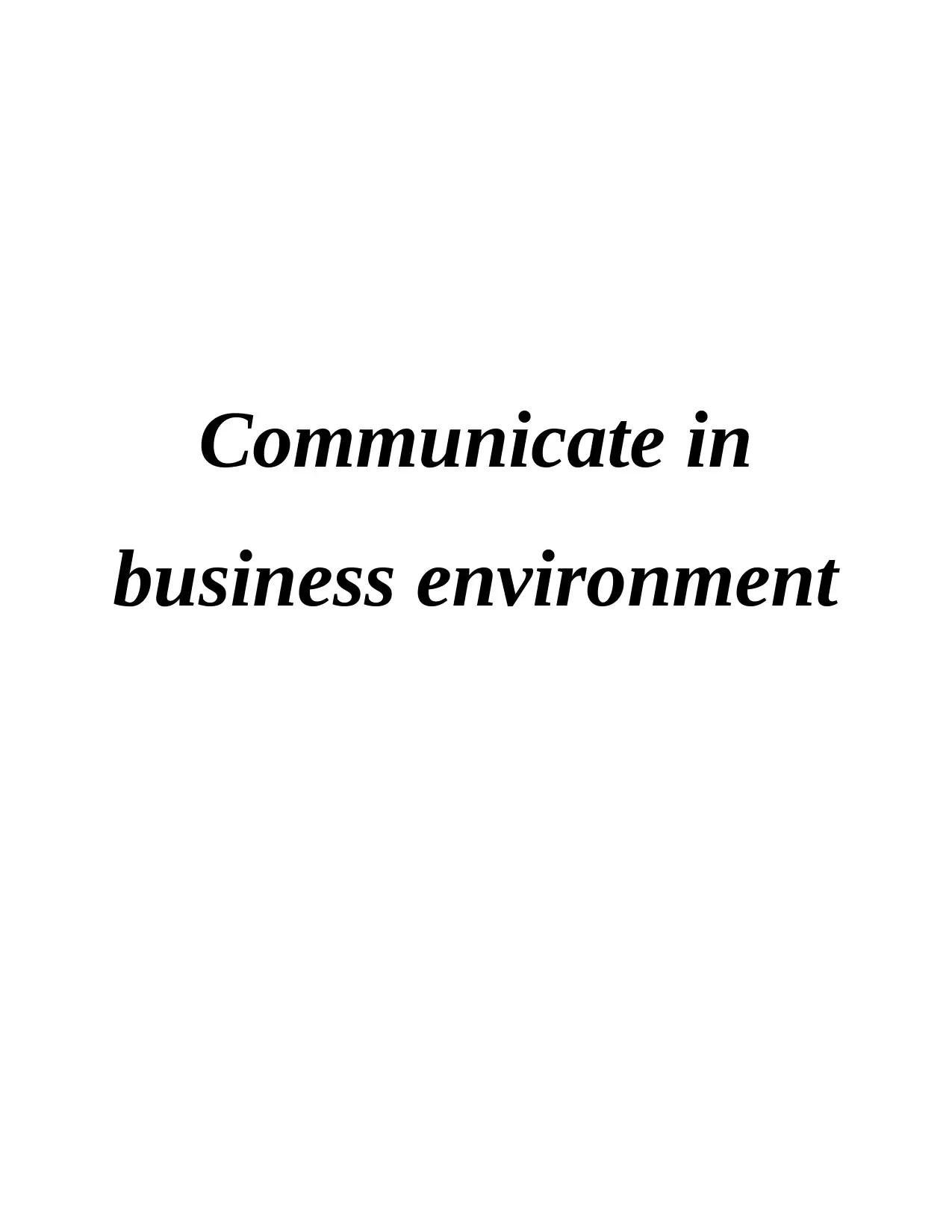
Communicate in
business environment
business environment
Secure Best Marks with AI Grader
Need help grading? Try our AI Grader for instant feedback on your assignments.
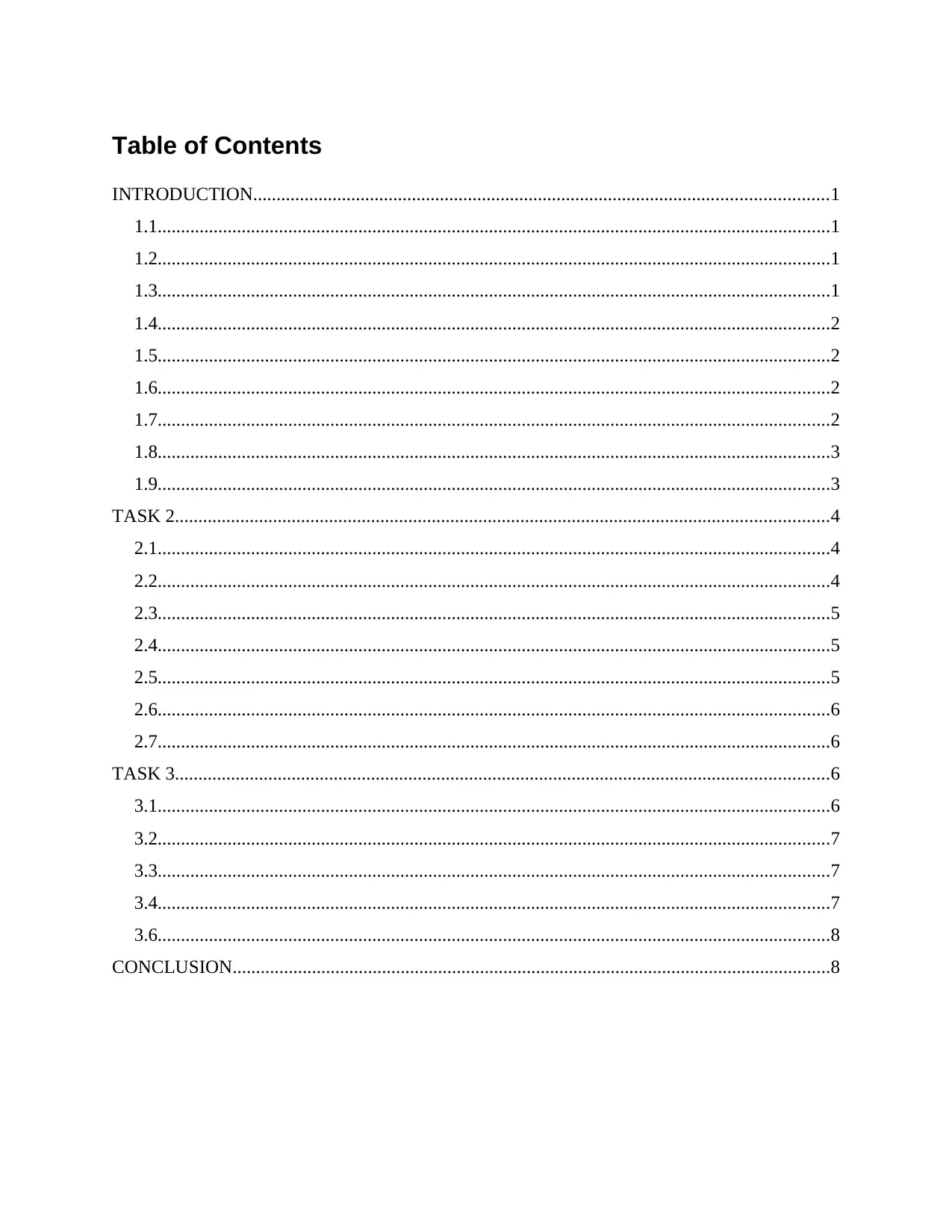
Table of Contents
INTRODUCTION...........................................................................................................................1
1.1................................................................................................................................................1
1.2................................................................................................................................................1
1.3................................................................................................................................................1
1.4................................................................................................................................................2
1.5................................................................................................................................................2
1.6................................................................................................................................................2
1.7................................................................................................................................................2
1.8................................................................................................................................................3
1.9................................................................................................................................................3
TASK 2............................................................................................................................................4
2.1................................................................................................................................................4
2.2................................................................................................................................................4
2.3................................................................................................................................................5
2.4................................................................................................................................................5
2.5................................................................................................................................................5
2.6................................................................................................................................................6
2.7................................................................................................................................................6
TASK 3............................................................................................................................................6
3.1................................................................................................................................................6
3.2................................................................................................................................................7
3.3................................................................................................................................................7
3.4................................................................................................................................................7
3.6................................................................................................................................................8
CONCLUSION................................................................................................................................8
INTRODUCTION...........................................................................................................................1
1.1................................................................................................................................................1
1.2................................................................................................................................................1
1.3................................................................................................................................................1
1.4................................................................................................................................................2
1.5................................................................................................................................................2
1.6................................................................................................................................................2
1.7................................................................................................................................................2
1.8................................................................................................................................................3
1.9................................................................................................................................................3
TASK 2............................................................................................................................................4
2.1................................................................................................................................................4
2.2................................................................................................................................................4
2.3................................................................................................................................................5
2.4................................................................................................................................................5
2.5................................................................................................................................................5
2.6................................................................................................................................................6
2.7................................................................................................................................................6
TASK 3............................................................................................................................................6
3.1................................................................................................................................................6
3.2................................................................................................................................................7
3.3................................................................................................................................................7
3.4................................................................................................................................................7
3.6................................................................................................................................................8
CONCLUSION................................................................................................................................8
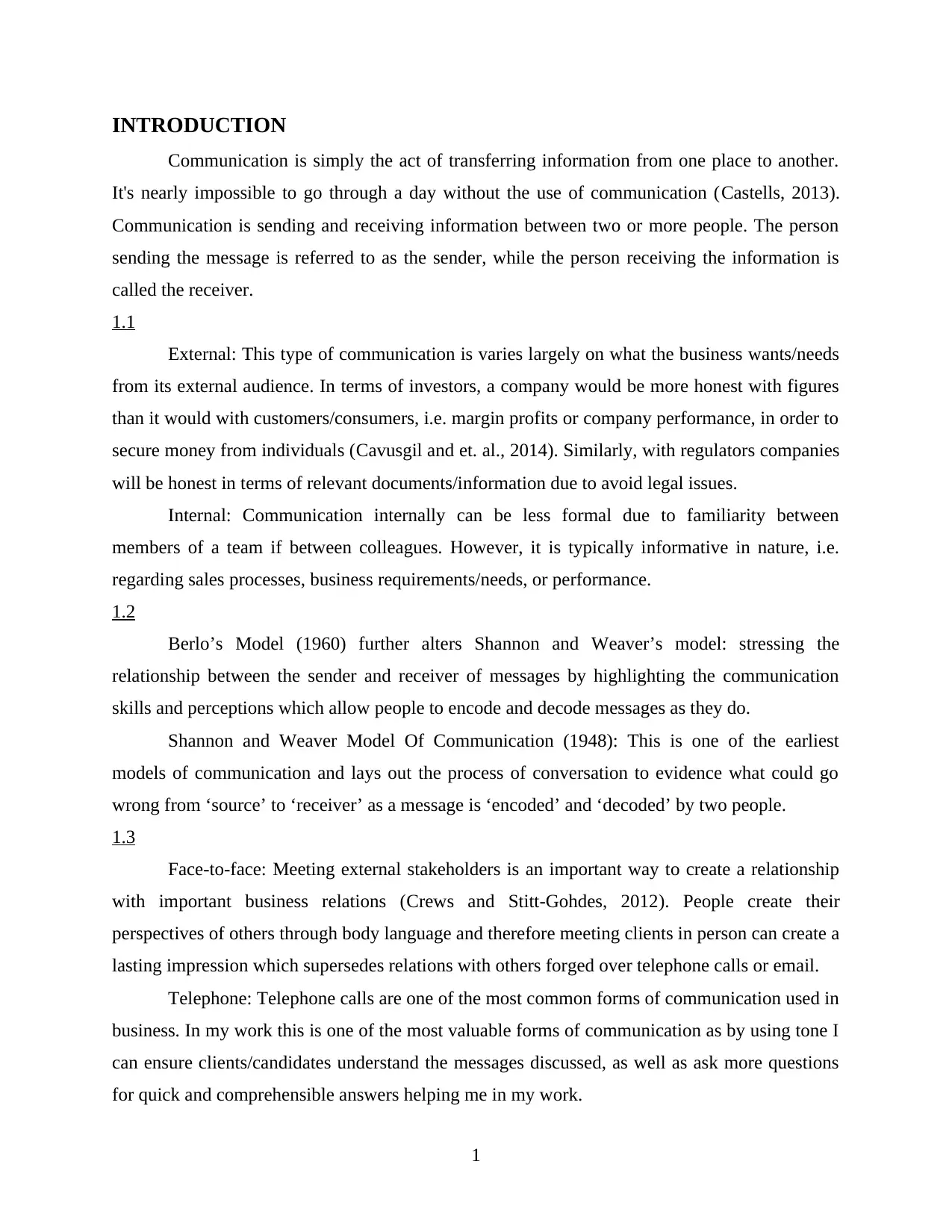
INTRODUCTION
Communication is simply the act of transferring information from one place to another.
It's nearly impossible to go through a day without the use of communication (Castells, 2013).
Communication is sending and receiving information between two or more people. The person
sending the message is referred to as the sender, while the person receiving the information is
called the receiver.
1.1
External: This type of communication is varies largely on what the business wants/needs
from its external audience. In terms of investors, a company would be more honest with figures
than it would with customers/consumers, i.e. margin profits or company performance, in order to
secure money from individuals (Cavusgil and et. al., 2014). Similarly, with regulators companies
will be honest in terms of relevant documents/information due to avoid legal issues.
Internal: Communication internally can be less formal due to familiarity between
members of a team if between colleagues. However, it is typically informative in nature, i.e.
regarding sales processes, business requirements/needs, or performance.
1.2
Berlo’s Model (1960) further alters Shannon and Weaver’s model: stressing the
relationship between the sender and receiver of messages by highlighting the communication
skills and perceptions which allow people to encode and decode messages as they do.
Shannon and Weaver Model Of Communication (1948): This is one of the earliest
models of communication and lays out the process of conversation to evidence what could go
wrong from ‘source’ to ‘receiver’ as a message is ‘encoded’ and ‘decoded’ by two people.
1.3
Face-to-face: Meeting external stakeholders is an important way to create a relationship
with important business relations (Crews and Stitt-Gohdes, 2012). People create their
perspectives of others through body language and therefore meeting clients in person can create a
lasting impression which supersedes relations with others forged over telephone calls or email.
Telephone: Telephone calls are one of the most common forms of communication used in
business. In my work this is one of the most valuable forms of communication as by using tone I
can ensure clients/candidates understand the messages discussed, as well as ask more questions
for quick and comprehensible answers helping me in my work.
1
Communication is simply the act of transferring information from one place to another.
It's nearly impossible to go through a day without the use of communication (Castells, 2013).
Communication is sending and receiving information between two or more people. The person
sending the message is referred to as the sender, while the person receiving the information is
called the receiver.
1.1
External: This type of communication is varies largely on what the business wants/needs
from its external audience. In terms of investors, a company would be more honest with figures
than it would with customers/consumers, i.e. margin profits or company performance, in order to
secure money from individuals (Cavusgil and et. al., 2014). Similarly, with regulators companies
will be honest in terms of relevant documents/information due to avoid legal issues.
Internal: Communication internally can be less formal due to familiarity between
members of a team if between colleagues. However, it is typically informative in nature, i.e.
regarding sales processes, business requirements/needs, or performance.
1.2
Berlo’s Model (1960) further alters Shannon and Weaver’s model: stressing the
relationship between the sender and receiver of messages by highlighting the communication
skills and perceptions which allow people to encode and decode messages as they do.
Shannon and Weaver Model Of Communication (1948): This is one of the earliest
models of communication and lays out the process of conversation to evidence what could go
wrong from ‘source’ to ‘receiver’ as a message is ‘encoded’ and ‘decoded’ by two people.
1.3
Face-to-face: Meeting external stakeholders is an important way to create a relationship
with important business relations (Crews and Stitt-Gohdes, 2012). People create their
perspectives of others through body language and therefore meeting clients in person can create a
lasting impression which supersedes relations with others forged over telephone calls or email.
Telephone: Telephone calls are one of the most common forms of communication used in
business. In my work this is one of the most valuable forms of communication as by using tone I
can ensure clients/candidates understand the messages discussed, as well as ask more questions
for quick and comprehensible answers helping me in my work.
1
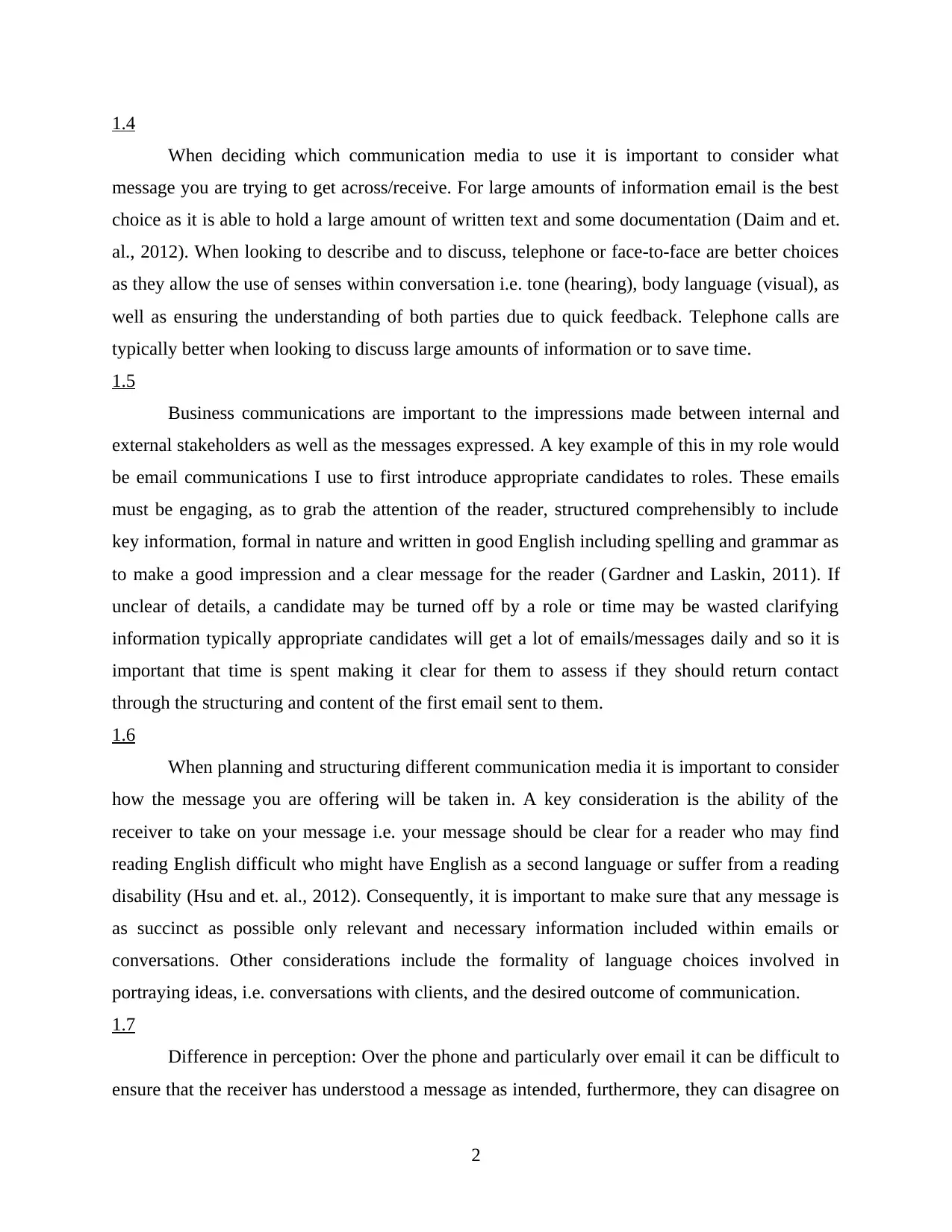
1.4
When deciding which communication media to use it is important to consider what
message you are trying to get across/receive. For large amounts of information email is the best
choice as it is able to hold a large amount of written text and some documentation (Daim and et.
al., 2012). When looking to describe and to discuss, telephone or face-to-face are better choices
as they allow the use of senses within conversation i.e. tone (hearing), body language (visual), as
well as ensuring the understanding of both parties due to quick feedback. Telephone calls are
typically better when looking to discuss large amounts of information or to save time.
1.5
Business communications are important to the impressions made between internal and
external stakeholders as well as the messages expressed. A key example of this in my role would
be email communications I use to first introduce appropriate candidates to roles. These emails
must be engaging, as to grab the attention of the reader, structured comprehensibly to include
key information, formal in nature and written in good English including spelling and grammar as
to make a good impression and a clear message for the reader (Gardner and Laskin, 2011). If
unclear of details, a candidate may be turned off by a role or time may be wasted clarifying
information typically appropriate candidates will get a lot of emails/messages daily and so it is
important that time is spent making it clear for them to assess if they should return contact
through the structuring and content of the first email sent to them.
1.6
When planning and structuring different communication media it is important to consider
how the message you are offering will be taken in. A key consideration is the ability of the
receiver to take on your message i.e. your message should be clear for a reader who may find
reading English difficult who might have English as a second language or suffer from a reading
disability (Hsu and et. al., 2012). Consequently, it is important to make sure that any message is
as succinct as possible only relevant and necessary information included within emails or
conversations. Other considerations include the formality of language choices involved in
portraying ideas, i.e. conversations with clients, and the desired outcome of communication.
1.7
Difference in perception: Over the phone and particularly over email it can be difficult to
ensure that the receiver has understood a message as intended, furthermore, they can disagree on
2
When deciding which communication media to use it is important to consider what
message you are trying to get across/receive. For large amounts of information email is the best
choice as it is able to hold a large amount of written text and some documentation (Daim and et.
al., 2012). When looking to describe and to discuss, telephone or face-to-face are better choices
as they allow the use of senses within conversation i.e. tone (hearing), body language (visual), as
well as ensuring the understanding of both parties due to quick feedback. Telephone calls are
typically better when looking to discuss large amounts of information or to save time.
1.5
Business communications are important to the impressions made between internal and
external stakeholders as well as the messages expressed. A key example of this in my role would
be email communications I use to first introduce appropriate candidates to roles. These emails
must be engaging, as to grab the attention of the reader, structured comprehensibly to include
key information, formal in nature and written in good English including spelling and grammar as
to make a good impression and a clear message for the reader (Gardner and Laskin, 2011). If
unclear of details, a candidate may be turned off by a role or time may be wasted clarifying
information typically appropriate candidates will get a lot of emails/messages daily and so it is
important that time is spent making it clear for them to assess if they should return contact
through the structuring and content of the first email sent to them.
1.6
When planning and structuring different communication media it is important to consider
how the message you are offering will be taken in. A key consideration is the ability of the
receiver to take on your message i.e. your message should be clear for a reader who may find
reading English difficult who might have English as a second language or suffer from a reading
disability (Hsu and et. al., 2012). Consequently, it is important to make sure that any message is
as succinct as possible only relevant and necessary information included within emails or
conversations. Other considerations include the formality of language choices involved in
portraying ideas, i.e. conversations with clients, and the desired outcome of communication.
1.7
Difference in perception: Over the phone and particularly over email it can be difficult to
ensure that the receiver has understood a message as intended, furthermore, they can disagree on
2
Secure Best Marks with AI Grader
Need help grading? Try our AI Grader for instant feedback on your assignments.
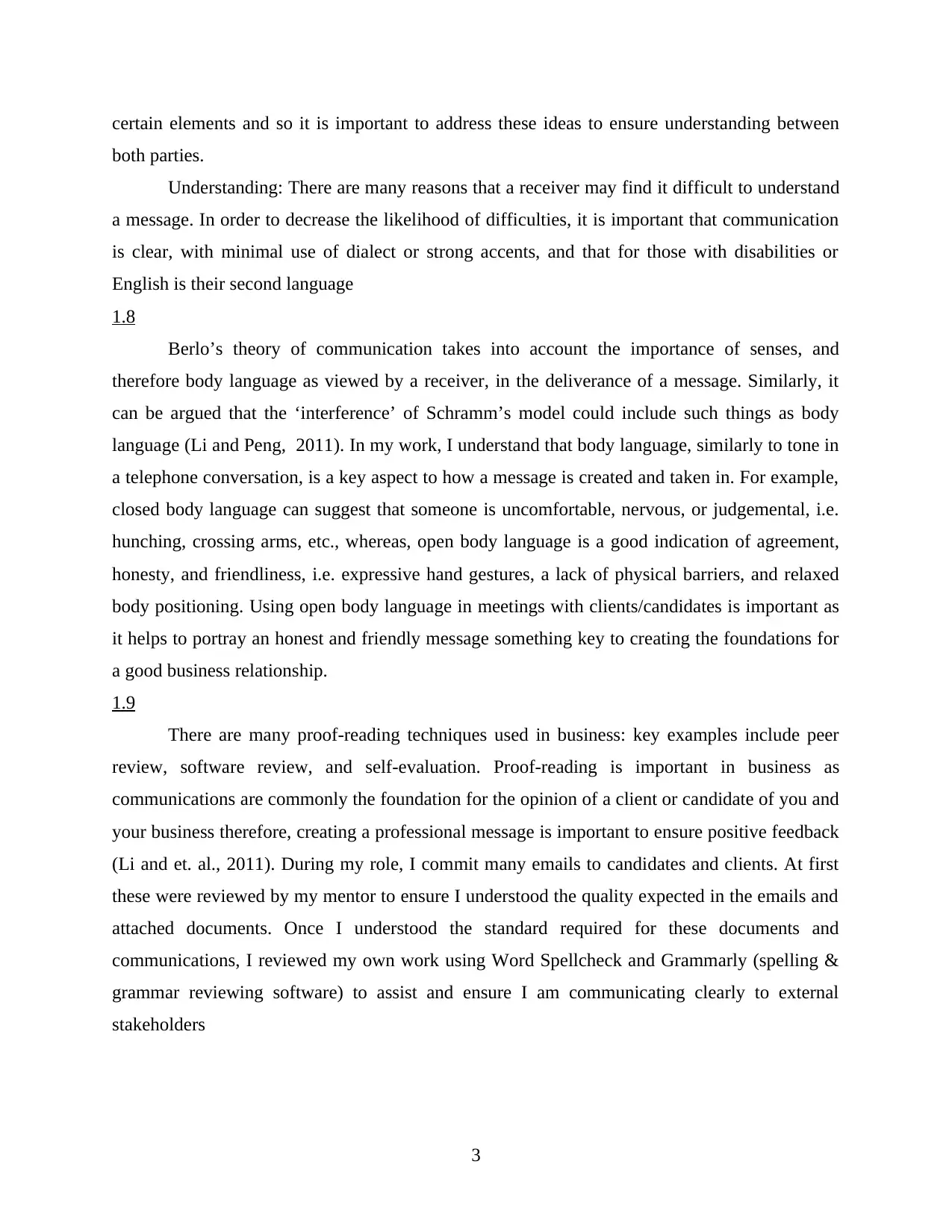
certain elements and so it is important to address these ideas to ensure understanding between
both parties.
Understanding: There are many reasons that a receiver may find it difficult to understand
a message. In order to decrease the likelihood of difficulties, it is important that communication
is clear, with minimal use of dialect or strong accents, and that for those with disabilities or
English is their second language
1.8
Berlo’s theory of communication takes into account the importance of senses, and
therefore body language as viewed by a receiver, in the deliverance of a message. Similarly, it
can be argued that the ‘interference’ of Schramm’s model could include such things as body
language (Li and Peng, 2011). In my work, I understand that body language, similarly to tone in
a telephone conversation, is a key aspect to how a message is created and taken in. For example,
closed body language can suggest that someone is uncomfortable, nervous, or judgemental, i.e.
hunching, crossing arms, etc., whereas, open body language is a good indication of agreement,
honesty, and friendliness, i.e. expressive hand gestures, a lack of physical barriers, and relaxed
body positioning. Using open body language in meetings with clients/candidates is important as
it helps to portray an honest and friendly message something key to creating the foundations for
a good business relationship.
1.9
There are many proof-reading techniques used in business: key examples include peer
review, software review, and self-evaluation. Proof-reading is important in business as
communications are commonly the foundation for the opinion of a client or candidate of you and
your business therefore, creating a professional message is important to ensure positive feedback
(Li and et. al., 2011). During my role, I commit many emails to candidates and clients. At first
these were reviewed by my mentor to ensure I understood the quality expected in the emails and
attached documents. Once I understood the standard required for these documents and
communications, I reviewed my own work using Word Spellcheck and Grammarly (spelling &
grammar reviewing software) to assist and ensure I am communicating clearly to external
stakeholders
3
both parties.
Understanding: There are many reasons that a receiver may find it difficult to understand
a message. In order to decrease the likelihood of difficulties, it is important that communication
is clear, with minimal use of dialect or strong accents, and that for those with disabilities or
English is their second language
1.8
Berlo’s theory of communication takes into account the importance of senses, and
therefore body language as viewed by a receiver, in the deliverance of a message. Similarly, it
can be argued that the ‘interference’ of Schramm’s model could include such things as body
language (Li and Peng, 2011). In my work, I understand that body language, similarly to tone in
a telephone conversation, is a key aspect to how a message is created and taken in. For example,
closed body language can suggest that someone is uncomfortable, nervous, or judgemental, i.e.
hunching, crossing arms, etc., whereas, open body language is a good indication of agreement,
honesty, and friendliness, i.e. expressive hand gestures, a lack of physical barriers, and relaxed
body positioning. Using open body language in meetings with clients/candidates is important as
it helps to portray an honest and friendly message something key to creating the foundations for
a good business relationship.
1.9
There are many proof-reading techniques used in business: key examples include peer
review, software review, and self-evaluation. Proof-reading is important in business as
communications are commonly the foundation for the opinion of a client or candidate of you and
your business therefore, creating a professional message is important to ensure positive feedback
(Li and et. al., 2011). During my role, I commit many emails to candidates and clients. At first
these were reviewed by my mentor to ensure I understood the quality expected in the emails and
attached documents. Once I understood the standard required for these documents and
communications, I reviewed my own work using Word Spellcheck and Grammarly (spelling &
grammar reviewing software) to assist and ensure I am communicating clearly to external
stakeholders
3
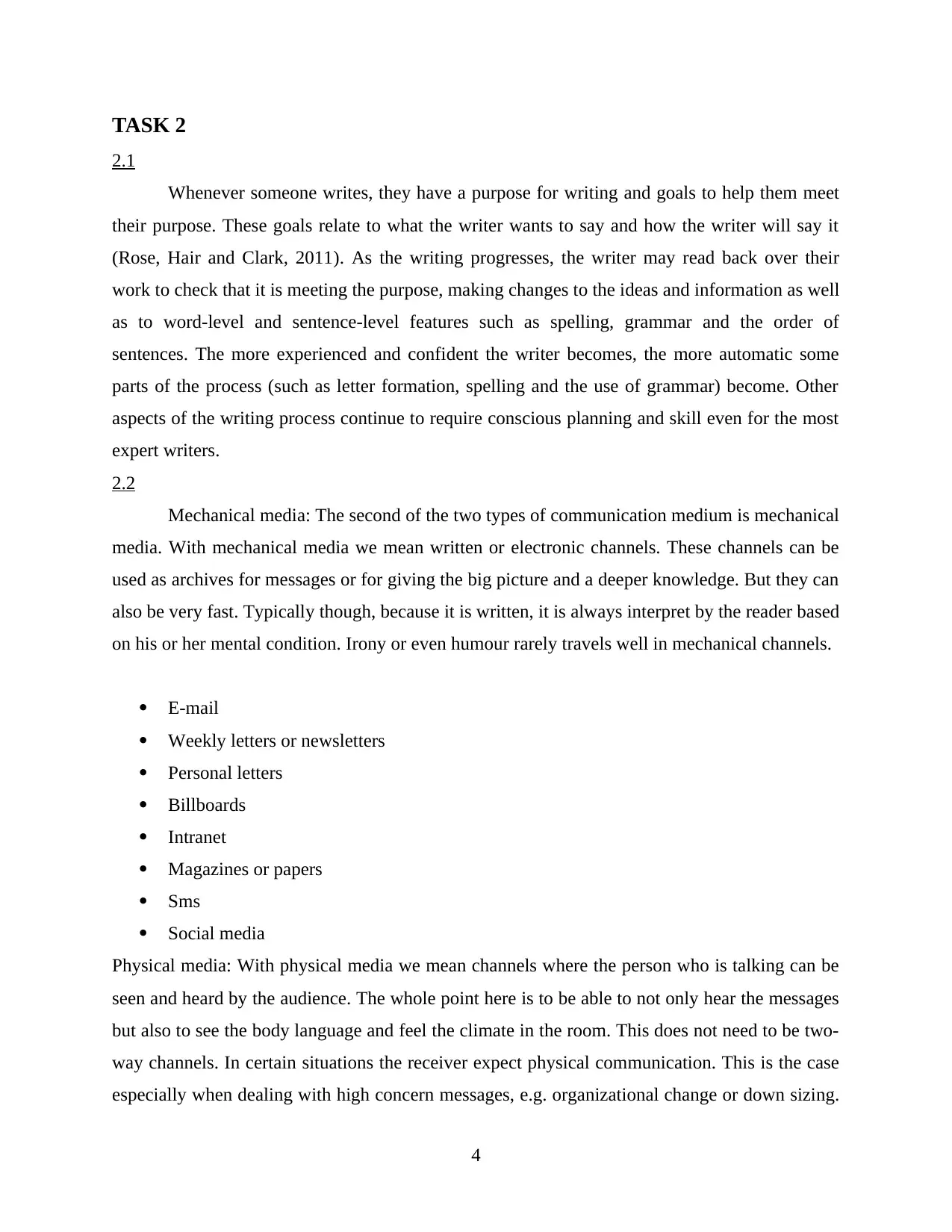
TASK 2
2.1
Whenever someone writes, they have a purpose for writing and goals to help them meet
their purpose. These goals relate to what the writer wants to say and how the writer will say it
(Rose, Hair and Clark, 2011). As the writing progresses, the writer may read back over their
work to check that it is meeting the purpose, making changes to the ideas and information as well
as to word-level and sentence-level features such as spelling, grammar and the order of
sentences. The more experienced and confident the writer becomes, the more automatic some
parts of the process (such as letter formation, spelling and the use of grammar) become. Other
aspects of the writing process continue to require conscious planning and skill even for the most
expert writers.
2.2
Mechanical media: The second of the two types of communication medium is mechanical
media. With mechanical media we mean written or electronic channels. These channels can be
used as archives for messages or for giving the big picture and a deeper knowledge. But they can
also be very fast. Typically though, because it is written, it is always interpret by the reader based
on his or her mental condition. Irony or even humour rarely travels well in mechanical channels.
E-mail
Weekly letters or newsletters
Personal letters
Billboards
Intranet
Magazines or papers
Sms
Social media
Physical media: With physical media we mean channels where the person who is talking can be
seen and heard by the audience. The whole point here is to be able to not only hear the messages
but also to see the body language and feel the climate in the room. This does not need to be two-
way channels. In certain situations the receiver expect physical communication. This is the case
especially when dealing with high concern messages, e.g. organizational change or down sizing.
4
2.1
Whenever someone writes, they have a purpose for writing and goals to help them meet
their purpose. These goals relate to what the writer wants to say and how the writer will say it
(Rose, Hair and Clark, 2011). As the writing progresses, the writer may read back over their
work to check that it is meeting the purpose, making changes to the ideas and information as well
as to word-level and sentence-level features such as spelling, grammar and the order of
sentences. The more experienced and confident the writer becomes, the more automatic some
parts of the process (such as letter formation, spelling and the use of grammar) become. Other
aspects of the writing process continue to require conscious planning and skill even for the most
expert writers.
2.2
Mechanical media: The second of the two types of communication medium is mechanical
media. With mechanical media we mean written or electronic channels. These channels can be
used as archives for messages or for giving the big picture and a deeper knowledge. But they can
also be very fast. Typically though, because it is written, it is always interpret by the reader based
on his or her mental condition. Irony or even humour rarely travels well in mechanical channels.
Weekly letters or newsletters
Personal letters
Billboards
Intranet
Magazines or papers
Sms
Social media
Physical media: With physical media we mean channels where the person who is talking can be
seen and heard by the audience. The whole point here is to be able to not only hear the messages
but also to see the body language and feel the climate in the room. This does not need to be two-
way channels. In certain situations the receiver expect physical communication. This is the case
especially when dealing with high concern messages, e.g. organizational change or down sizing.
4
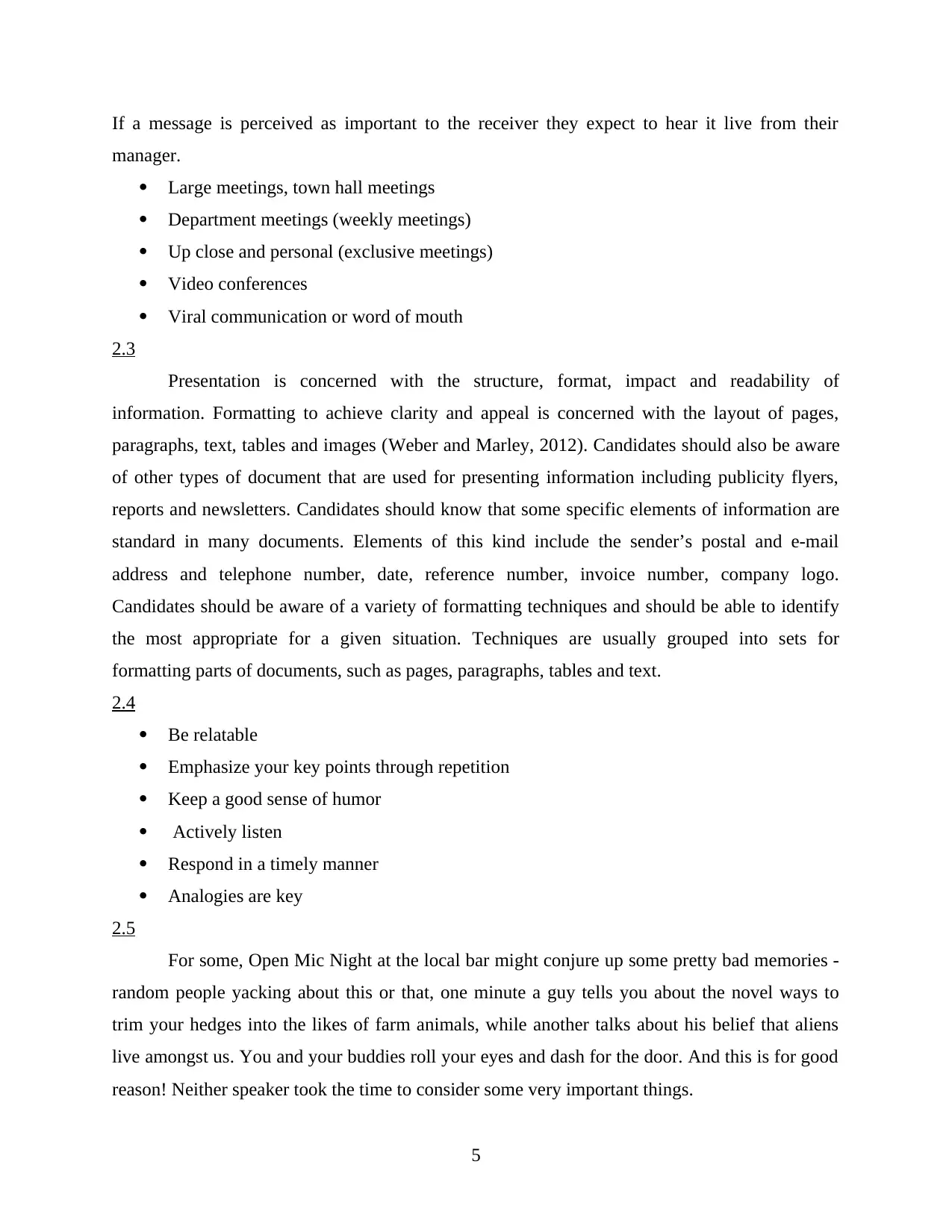
If a message is perceived as important to the receiver they expect to hear it live from their
manager.
Large meetings, town hall meetings
Department meetings (weekly meetings)
Up close and personal (exclusive meetings)
Video conferences
Viral communication or word of mouth
2.3
Presentation is concerned with the structure, format, impact and readability of
information. Formatting to achieve clarity and appeal is concerned with the layout of pages,
paragraphs, text, tables and images (Weber and Marley, 2012). Candidates should also be aware
of other types of document that are used for presenting information including publicity flyers,
reports and newsletters. Candidates should know that some specific elements of information are
standard in many documents. Elements of this kind include the sender’s postal and e-mail
address and telephone number, date, reference number, invoice number, company logo.
Candidates should be aware of a variety of formatting techniques and should be able to identify
the most appropriate for a given situation. Techniques are usually grouped into sets for
formatting parts of documents, such as pages, paragraphs, tables and text.
2.4
Be relatable
Emphasize your key points through repetition
Keep a good sense of humor
Actively listen
Respond in a timely manner
Analogies are key
2.5
For some, Open Mic Night at the local bar might conjure up some pretty bad memories -
random people yacking about this or that, one minute a guy tells you about the novel ways to
trim your hedges into the likes of farm animals, while another talks about his belief that aliens
live amongst us. You and your buddies roll your eyes and dash for the door. And this is for good
reason! Neither speaker took the time to consider some very important things.
5
manager.
Large meetings, town hall meetings
Department meetings (weekly meetings)
Up close and personal (exclusive meetings)
Video conferences
Viral communication or word of mouth
2.3
Presentation is concerned with the structure, format, impact and readability of
information. Formatting to achieve clarity and appeal is concerned with the layout of pages,
paragraphs, text, tables and images (Weber and Marley, 2012). Candidates should also be aware
of other types of document that are used for presenting information including publicity flyers,
reports and newsletters. Candidates should know that some specific elements of information are
standard in many documents. Elements of this kind include the sender’s postal and e-mail
address and telephone number, date, reference number, invoice number, company logo.
Candidates should be aware of a variety of formatting techniques and should be able to identify
the most appropriate for a given situation. Techniques are usually grouped into sets for
formatting parts of documents, such as pages, paragraphs, tables and text.
2.4
Be relatable
Emphasize your key points through repetition
Keep a good sense of humor
Actively listen
Respond in a timely manner
Analogies are key
2.5
For some, Open Mic Night at the local bar might conjure up some pretty bad memories -
random people yacking about this or that, one minute a guy tells you about the novel ways to
trim your hedges into the likes of farm animals, while another talks about his belief that aliens
live amongst us. You and your buddies roll your eyes and dash for the door. And this is for good
reason! Neither speaker took the time to consider some very important things.
5
Paraphrase This Document
Need a fresh take? Get an instant paraphrase of this document with our AI Paraphraser
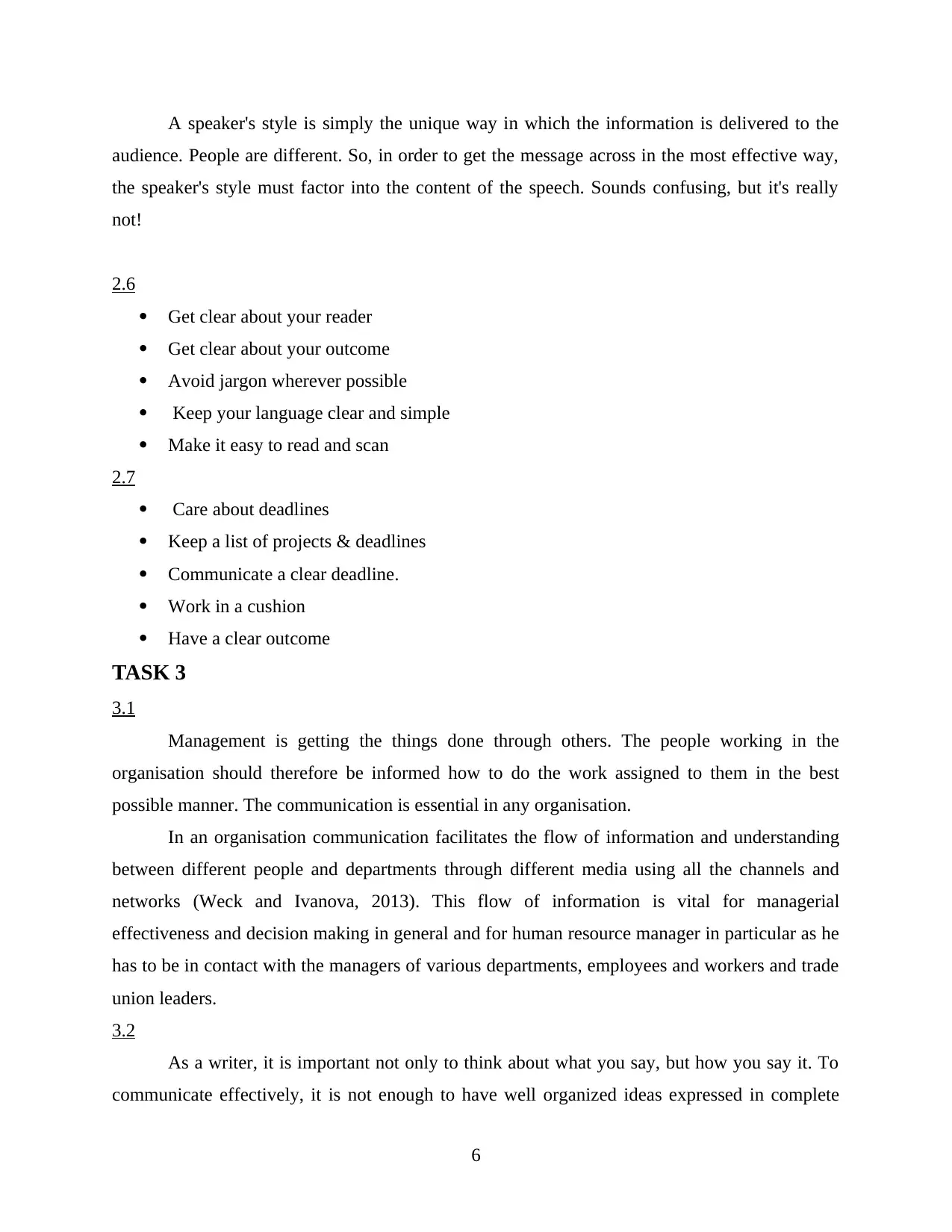
A speaker's style is simply the unique way in which the information is delivered to the
audience. People are different. So, in order to get the message across in the most effective way,
the speaker's style must factor into the content of the speech. Sounds confusing, but it's really
not!
2.6
Get clear about your reader
Get clear about your outcome
Avoid jargon wherever possible
Keep your language clear and simple
Make it easy to read and scan
2.7
Care about deadlines
Keep a list of projects & deadlines
Communicate a clear deadline.
Work in a cushion
Have a clear outcome
TASK 3
3.1
Management is getting the things done through others. The people working in the
organisation should therefore be informed how to do the work assigned to them in the best
possible manner. The communication is essential in any organisation.
In an organisation communication facilitates the flow of information and understanding
between different people and departments through different media using all the channels and
networks (Weck and Ivanova, 2013). This flow of information is vital for managerial
effectiveness and decision making in general and for human resource manager in particular as he
has to be in contact with the managers of various departments, employees and workers and trade
union leaders.
3.2
As a writer, it is important not only to think about what you say, but how you say it. To
communicate effectively, it is not enough to have well organized ideas expressed in complete
6
audience. People are different. So, in order to get the message across in the most effective way,
the speaker's style must factor into the content of the speech. Sounds confusing, but it's really
not!
2.6
Get clear about your reader
Get clear about your outcome
Avoid jargon wherever possible
Keep your language clear and simple
Make it easy to read and scan
2.7
Care about deadlines
Keep a list of projects & deadlines
Communicate a clear deadline.
Work in a cushion
Have a clear outcome
TASK 3
3.1
Management is getting the things done through others. The people working in the
organisation should therefore be informed how to do the work assigned to them in the best
possible manner. The communication is essential in any organisation.
In an organisation communication facilitates the flow of information and understanding
between different people and departments through different media using all the channels and
networks (Weck and Ivanova, 2013). This flow of information is vital for managerial
effectiveness and decision making in general and for human resource manager in particular as he
has to be in contact with the managers of various departments, employees and workers and trade
union leaders.
3.2
As a writer, it is important not only to think about what you say, but how you say it. To
communicate effectively, it is not enough to have well organized ideas expressed in complete
6
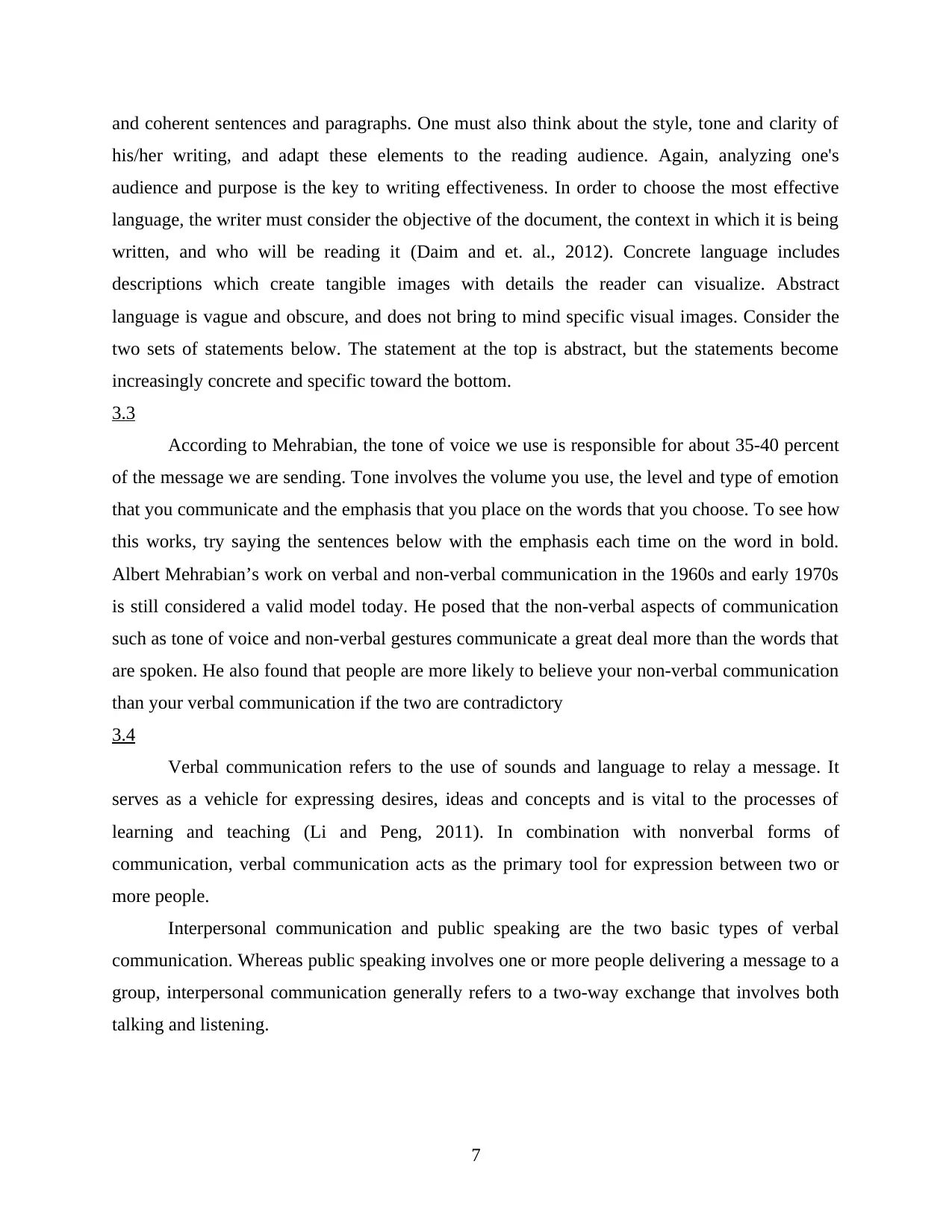
and coherent sentences and paragraphs. One must also think about the style, tone and clarity of
his/her writing, and adapt these elements to the reading audience. Again, analyzing one's
audience and purpose is the key to writing effectiveness. In order to choose the most effective
language, the writer must consider the objective of the document, the context in which it is being
written, and who will be reading it (Daim and et. al., 2012). Concrete language includes
descriptions which create tangible images with details the reader can visualize. Abstract
language is vague and obscure, and does not bring to mind specific visual images. Consider the
two sets of statements below. The statement at the top is abstract, but the statements become
increasingly concrete and specific toward the bottom.
3.3
According to Mehrabian, the tone of voice we use is responsible for about 35-40 percent
of the message we are sending. Tone involves the volume you use, the level and type of emotion
that you communicate and the emphasis that you place on the words that you choose. To see how
this works, try saying the sentences below with the emphasis each time on the word in bold.
Albert Mehrabian’s work on verbal and non-verbal communication in the 1960s and early 1970s
is still considered a valid model today. He posed that the non-verbal aspects of communication
such as tone of voice and non-verbal gestures communicate a great deal more than the words that
are spoken. He also found that people are more likely to believe your non-verbal communication
than your verbal communication if the two are contradictory
3.4
Verbal communication refers to the use of sounds and language to relay a message. It
serves as a vehicle for expressing desires, ideas and concepts and is vital to the processes of
learning and teaching (Li and Peng, 2011). In combination with nonverbal forms of
communication, verbal communication acts as the primary tool for expression between two or
more people.
Interpersonal communication and public speaking are the two basic types of verbal
communication. Whereas public speaking involves one or more people delivering a message to a
group, interpersonal communication generally refers to a two-way exchange that involves both
talking and listening.
7
his/her writing, and adapt these elements to the reading audience. Again, analyzing one's
audience and purpose is the key to writing effectiveness. In order to choose the most effective
language, the writer must consider the objective of the document, the context in which it is being
written, and who will be reading it (Daim and et. al., 2012). Concrete language includes
descriptions which create tangible images with details the reader can visualize. Abstract
language is vague and obscure, and does not bring to mind specific visual images. Consider the
two sets of statements below. The statement at the top is abstract, but the statements become
increasingly concrete and specific toward the bottom.
3.3
According to Mehrabian, the tone of voice we use is responsible for about 35-40 percent
of the message we are sending. Tone involves the volume you use, the level and type of emotion
that you communicate and the emphasis that you place on the words that you choose. To see how
this works, try saying the sentences below with the emphasis each time on the word in bold.
Albert Mehrabian’s work on verbal and non-verbal communication in the 1960s and early 1970s
is still considered a valid model today. He posed that the non-verbal aspects of communication
such as tone of voice and non-verbal gestures communicate a great deal more than the words that
are spoken. He also found that people are more likely to believe your non-verbal communication
than your verbal communication if the two are contradictory
3.4
Verbal communication refers to the use of sounds and language to relay a message. It
serves as a vehicle for expressing desires, ideas and concepts and is vital to the processes of
learning and teaching (Li and Peng, 2011). In combination with nonverbal forms of
communication, verbal communication acts as the primary tool for expression between two or
more people.
Interpersonal communication and public speaking are the two basic types of verbal
communication. Whereas public speaking involves one or more people delivering a message to a
group, interpersonal communication generally refers to a two-way exchange that involves both
talking and listening.
7
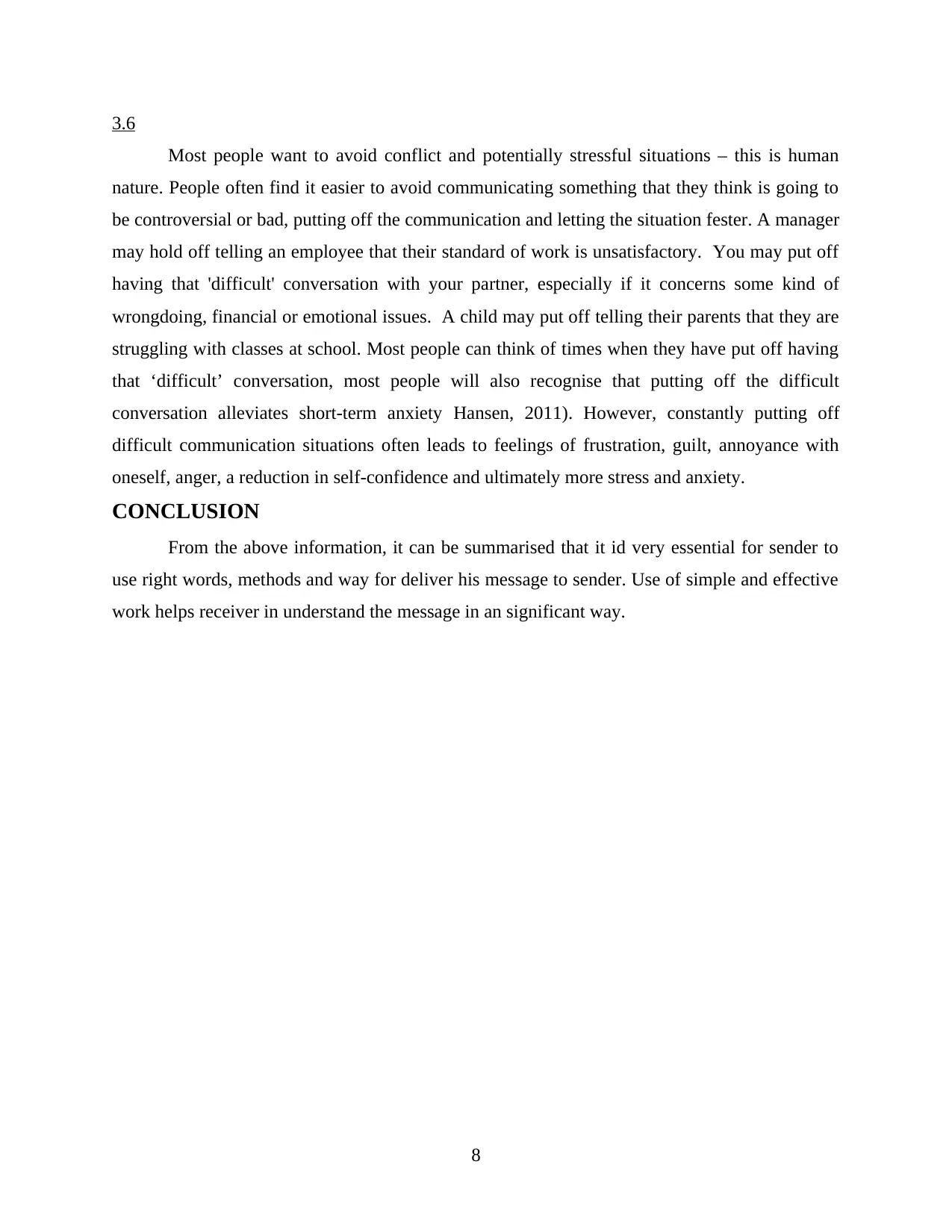
3.6
Most people want to avoid conflict and potentially stressful situations – this is human
nature. People often find it easier to avoid communicating something that they think is going to
be controversial or bad, putting off the communication and letting the situation fester. A manager
may hold off telling an employee that their standard of work is unsatisfactory. You may put off
having that 'difficult' conversation with your partner, especially if it concerns some kind of
wrongdoing, financial or emotional issues. A child may put off telling their parents that they are
struggling with classes at school. Most people can think of times when they have put off having
that ‘difficult’ conversation, most people will also recognise that putting off the difficult
conversation alleviates short-term anxiety Hansen, 2011). However, constantly putting off
difficult communication situations often leads to feelings of frustration, guilt, annoyance with
oneself, anger, a reduction in self-confidence and ultimately more stress and anxiety.
CONCLUSION
From the above information, it can be summarised that it id very essential for sender to
use right words, methods and way for deliver his message to sender. Use of simple and effective
work helps receiver in understand the message in an significant way.
8
Most people want to avoid conflict and potentially stressful situations – this is human
nature. People often find it easier to avoid communicating something that they think is going to
be controversial or bad, putting off the communication and letting the situation fester. A manager
may hold off telling an employee that their standard of work is unsatisfactory. You may put off
having that 'difficult' conversation with your partner, especially if it concerns some kind of
wrongdoing, financial or emotional issues. A child may put off telling their parents that they are
struggling with classes at school. Most people can think of times when they have put off having
that ‘difficult’ conversation, most people will also recognise that putting off the difficult
conversation alleviates short-term anxiety Hansen, 2011). However, constantly putting off
difficult communication situations often leads to feelings of frustration, guilt, annoyance with
oneself, anger, a reduction in self-confidence and ultimately more stress and anxiety.
CONCLUSION
From the above information, it can be summarised that it id very essential for sender to
use right words, methods and way for deliver his message to sender. Use of simple and effective
work helps receiver in understand the message in an significant way.
8
Secure Best Marks with AI Grader
Need help grading? Try our AI Grader for instant feedback on your assignments.
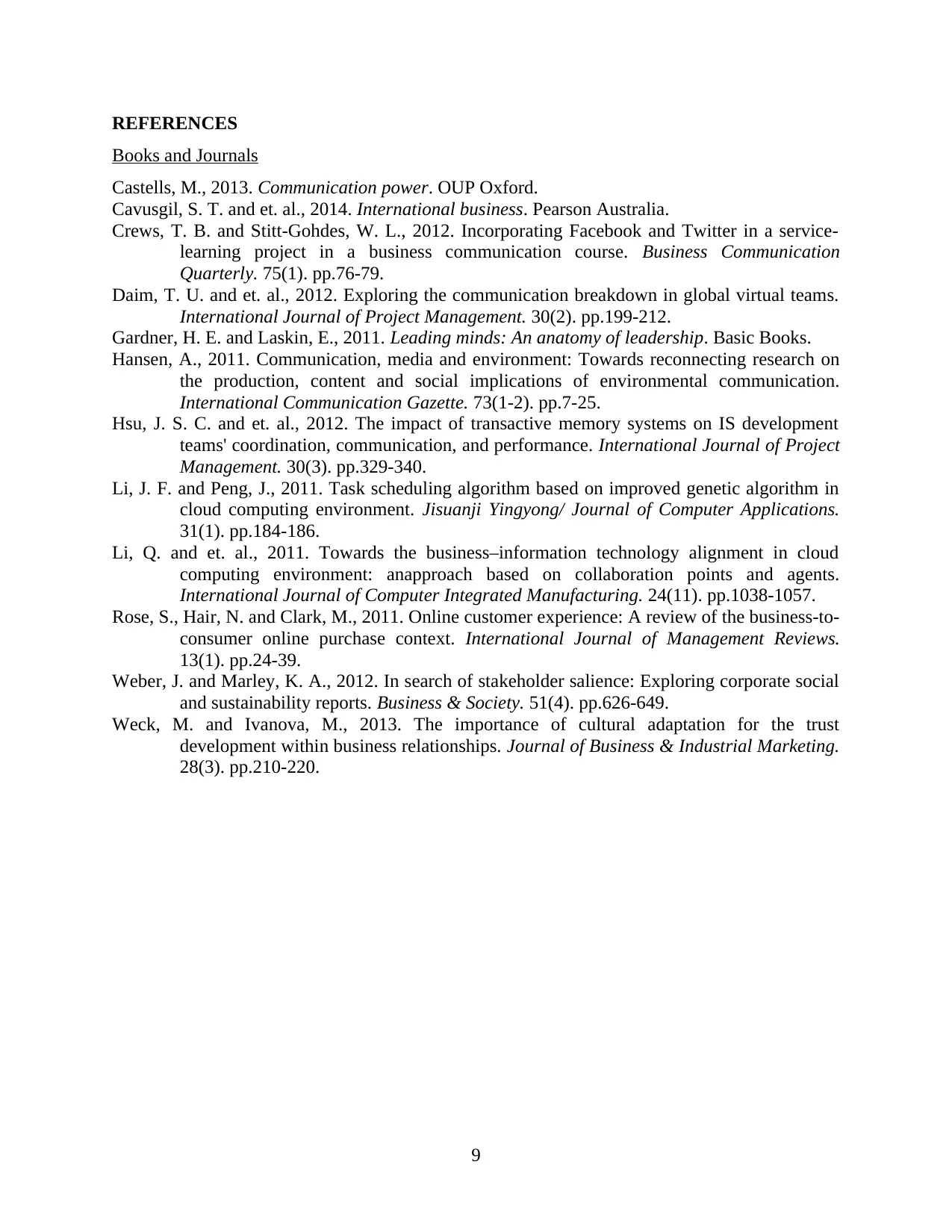
REFERENCES
Books and Journals
Castells, M., 2013. Communication power. OUP Oxford.
Cavusgil, S. T. and et. al., 2014. International business. Pearson Australia.
Crews, T. B. and Stitt-Gohdes, W. L., 2012. Incorporating Facebook and Twitter in a service-
learning project in a business communication course. Business Communication
Quarterly. 75(1). pp.76-79.
Daim, T. U. and et. al., 2012. Exploring the communication breakdown in global virtual teams.
International Journal of Project Management. 30(2). pp.199-212.
Gardner, H. E. and Laskin, E., 2011. Leading minds: An anatomy of leadership. Basic Books.
Hansen, A., 2011. Communication, media and environment: Towards reconnecting research on
the production, content and social implications of environmental communication.
International Communication Gazette. 73(1-2). pp.7-25.
Hsu, J. S. C. and et. al., 2012. The impact of transactive memory systems on IS development
teams' coordination, communication, and performance. International Journal of Project
Management. 30(3). pp.329-340.
Li, J. F. and Peng, J., 2011. Task scheduling algorithm based on improved genetic algorithm in
cloud computing environment. Jisuanji Yingyong/ Journal of Computer Applications.
31(1). pp.184-186.
Li, Q. and et. al., 2011. Towards the business–information technology alignment in cloud
computing environment: anapproach based on collaboration points and agents.
International Journal of Computer Integrated Manufacturing. 24(11). pp.1038-1057.
Rose, S., Hair, N. and Clark, M., 2011. Online customer experience: A review of the business‐to‐
consumer online purchase context. International Journal of Management Reviews.
13(1). pp.24-39.
Weber, J. and Marley, K. A., 2012. In search of stakeholder salience: Exploring corporate social
and sustainability reports. Business & Society. 51(4). pp.626-649.
Weck, M. and Ivanova, M., 2013. The importance of cultural adaptation for the trust
development within business relationships. Journal of Business & Industrial Marketing.
28(3). pp.210-220.
9
Books and Journals
Castells, M., 2013. Communication power. OUP Oxford.
Cavusgil, S. T. and et. al., 2014. International business. Pearson Australia.
Crews, T. B. and Stitt-Gohdes, W. L., 2012. Incorporating Facebook and Twitter in a service-
learning project in a business communication course. Business Communication
Quarterly. 75(1). pp.76-79.
Daim, T. U. and et. al., 2012. Exploring the communication breakdown in global virtual teams.
International Journal of Project Management. 30(2). pp.199-212.
Gardner, H. E. and Laskin, E., 2011. Leading minds: An anatomy of leadership. Basic Books.
Hansen, A., 2011. Communication, media and environment: Towards reconnecting research on
the production, content and social implications of environmental communication.
International Communication Gazette. 73(1-2). pp.7-25.
Hsu, J. S. C. and et. al., 2012. The impact of transactive memory systems on IS development
teams' coordination, communication, and performance. International Journal of Project
Management. 30(3). pp.329-340.
Li, J. F. and Peng, J., 2011. Task scheduling algorithm based on improved genetic algorithm in
cloud computing environment. Jisuanji Yingyong/ Journal of Computer Applications.
31(1). pp.184-186.
Li, Q. and et. al., 2011. Towards the business–information technology alignment in cloud
computing environment: anapproach based on collaboration points and agents.
International Journal of Computer Integrated Manufacturing. 24(11). pp.1038-1057.
Rose, S., Hair, N. and Clark, M., 2011. Online customer experience: A review of the business‐to‐
consumer online purchase context. International Journal of Management Reviews.
13(1). pp.24-39.
Weber, J. and Marley, K. A., 2012. In search of stakeholder salience: Exploring corporate social
and sustainability reports. Business & Society. 51(4). pp.626-649.
Weck, M. and Ivanova, M., 2013. The importance of cultural adaptation for the trust
development within business relationships. Journal of Business & Industrial Marketing.
28(3). pp.210-220.
9
1 out of 11
Related Documents
Your All-in-One AI-Powered Toolkit for Academic Success.
+13062052269
info@desklib.com
Available 24*7 on WhatsApp / Email
![[object Object]](/_next/static/media/star-bottom.7253800d.svg)
Unlock your academic potential
© 2024 | Zucol Services PVT LTD | All rights reserved.





